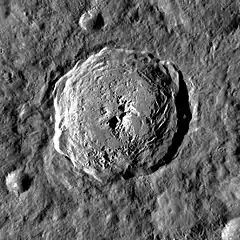Jackson (crater)
Jackson is a prominent lunar impact crater that is located in the northern hemisphere on the far side of the Moon. Less than one crater to the northeast is the crater Mineur, and to the south-southwest lies McMath.
 LRO WAC image | |
| Coordinates | 22.4°N 163.1°W |
|---|---|
| Diameter | 71.3 km |
| Depth | Unknown |
| Colongitude | 164° at sunrise |
| Eponym | John Jackson |

This crater created a large ray system. A skirt of higher-albedo material covers the surface within one crater diameter, with a slightly darker band along the outer ramparts. Beyond that radius, the rays form wide sections that grow increasingly diffuse and wispy with distance. The largest sections lie in roughly 90° arcs to the northeast and southwest, while a narrower arc projects to the south-southeast. The rays continue for hundreds of kilometers across the surface.
The rim of the crater is well-defined and not significantly worn. The edge is somewhat polygonal in shape, with the southeastern rim being more rounded. The inner walls display some terracing. The interior floor is generally level with some irregularities in the northeastern part. Parts of the floor have a relatively high albedo.
Jackson lies to the northwest of the Dirichlet-Jackson Basin.
Satellite craters
By convention these features are identified on lunar maps by placing the letter on the side of the crater midpoint that is closest to Jackson.
| Jackson | Latitude | Longitude | Diameter |
|---|---|---|---|
| Q | 21.1° N | 164.7° W | 13 km |
| X | 25.2° N | 164.3° W | 17 km |
External links
- Melt Fractures in Jackson Crater, Lunar Reconnaissance Orbiter Camera (LROC)
- Jackson's Complexity, Lunar Reconnaissance Orbiter Camera (LROC)
- Zowie! (Jackson's central peaks), Lunar Reconnaissance Orbiter Camera (LROC)
- KAGUYA Taking Around 'Jackson', HD video of SELENE crossing Jackson crater
References
- Andersson, L. E.; Whitaker, E. A. (1982). NASA Catalogue of Lunar Nomenclature. NASA RP-1097.CS1 maint: ref=harv (link)
- Blue, Jennifer (July 25, 2007). "Gazetteer of Planetary Nomenclature". USGS. Retrieved 2007-08-05.CS1 maint: ref=harv (link)
- Bussey, B.; Spudis, P. (2004). The Clementine Atlas of the Moon. New York: Cambridge University Press. ISBN 978-0-521-81528-4.CS1 maint: ref=harv (link)
- Cocks, Elijah E.; Cocks, Josiah C. (1995). Who's Who on the Moon: A Biographical Dictionary of Lunar Nomenclature. Tudor Publishers. ISBN 978-0-936389-27-1.CS1 maint: ref=harv (link)
- McDowell, Jonathan (July 15, 2007). "Lunar Nomenclature". Jonathan's Space Report. Retrieved 2007-10-24.CS1 maint: ref=harv (link)
- Menzel, D. H.; Minnaert, M.; Levin, B.; Dollfus, A.; Bell, B. (1971). "Report on Lunar Nomenclature by the Working Group of Commission 17 of the IAU". Space Science Reviews. 12 (2): 136–186. Bibcode:1971SSRv...12..136M. doi:10.1007/BF00171763.CS1 maint: ref=harv (link)
- Moore, Patrick (2001). On the Moon. Sterling Publishing Co. ISBN 978-0-304-35469-6.CS1 maint: ref=harv (link)
- Price, Fred W. (1988). The Moon Observer's Handbook. Cambridge University Press. ISBN 978-0-521-33500-3.CS1 maint: ref=harv (link)
- Rükl, Antonín (1990). Atlas of the Moon. Kalmbach Books. ISBN 978-0-913135-17-4.CS1 maint: ref=harv (link)
- Webb, Rev. T. W. (1962). Celestial Objects for Common Telescopes (6th revised ed.). Dover. ISBN 978-0-486-20917-3.CS1 maint: ref=harv (link)
- Whitaker, Ewen A. (1999). Mapping and Naming the Moon. Cambridge University Press. ISBN 978-0-521-62248-6.CS1 maint: ref=harv (link)
- Wlasuk, Peter T. (2000). Observing the Moon. Springer. ISBN 978-1-85233-193-1.CS1 maint: ref=harv (link)